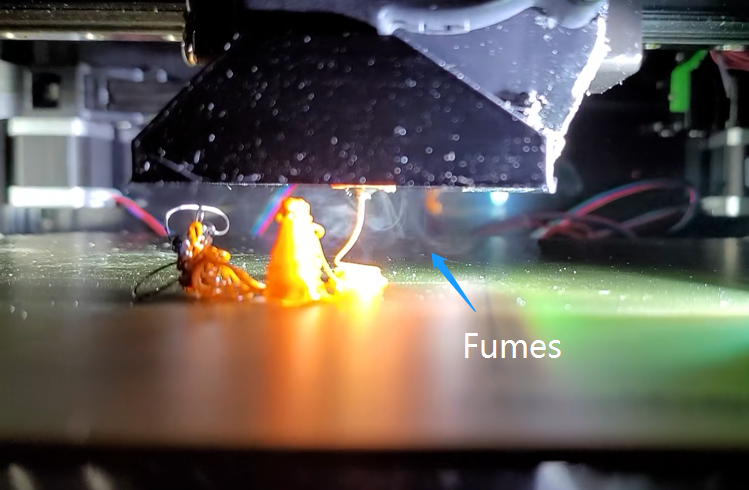Are 3D printer fumes Dangerous?
Aug 04,2023 | 3D4Create
The world of 3D printing is expanding rapidly, with more accessible desktop printers entering homes and schools. However, there are rising concerns about the safety of emissions and fumes from 3D printers.
Is your 3D printer exposing you to harmful ultrafine particles and VOCs? Let’s analyze the real risks.

I. Introduction
3D printing technology has revolutionized product design and manufacturing. From DIY hobbyists to industrial prototyping, 3D printers allow the rapid creation of models, parts, and products. But alarm bells are sounding over the largely unknown dangers of inhaling 3D printer fumes.
As 3D printers heat plastics and other materials to high temperatures, they can emit a complex mixture of fine and ultrafine particles, volatile organic compounds (VOCs), aldehydes, and other gases. The variability of materials used makes testing emissions difficult. However, early studies have identified respiratory, skin, and eye irritation along with nausea in exposed individuals.
With affordable desktop 3D printers ending up in homes, schools, offices, and maker spaces, understanding the real risks of 3D printer fumes is crucial.
II. Common 3D Printing Materials and Their Fumes
Not all 3D printing emits dangerous substances, but some of the most popular materials do release concerning fumes, especially when heated to the high temps required for extrusion or sintering.
- ABS – One of the most common plastics for FDM 3D printing filament, ABS (acrylonitrile butadiene styrene) releases styrene gas when heated. Styrene is a known respiratory and mucus membrane irritant and a possible carcinogen with long-term exposure.
- PLA – Polylactic acid filaments are popular for beginner FDM printing because PLA plastic releases relatively minor emissions during heating. However, there are concerns that PLA can degrade over time into formaldehyde, a known human carcinogen. PLA and ABS have more differences when it comes to 3D printing. You can choose the filaments based on your preference.
- Nylon – This durable and flexible FDM filament option emits caprolactam vapors during printing, which can cause eye, skin, and respiratory irritation. Some nylon powders are also combustible.
- Resins – Photopolymer resins used in VAT polymerization 3D printers contain a complex mix of acrylates, acrylamides, and photoinitiators that can release VOCs and ultrafine particles during curing with UV light.
III. Potential Health Effects of 3D Printer Fumes
Research into the human health impacts of 3D printer emissions is still in the early stages. But initial studies raise flags over both short and long-term effects for workers and hobbyists exposed regularly:
- Respiratory irritation – Breathing particle-laden fumes can cause immediate irritation of the throat and lungs. Studies found that 3D printing worsened asthma in sensitive individuals.
- Allergic reactions – Some materials like nylon contain respiratory sensitizers that can trigger allergic reactions with asthma-like symptoms in exposed people.
- Eye and skin irritation – Nanoparticles and Volatile organic compounds (VOCs) can irritate eyes, causing watering and redness. Some individuals experience dermatitis and skin rashes from direct contact.
- Nausea and headaches – The stench from heating some plastics like ABS can cause immediate feelings of nausea or headaches in those working around 3D printers.
- Long-term toxicity – Styrene emissions from ABS and metals like nickel have known carcinogenic effects with repeated exposure. More research is urgently needed on potential long-term health impacts.

3D printer fume may cause health risks in schools & workplaces (photo: Vent Tech)
IV. Key Factors That Affect the Risk Level of Printer Fumes
The level of risk posed by 3D printer emissions depends on multiple factors:
- The material being printed – PLA is far safer than ABS plastic or photopolymers. Ceramics and metals carry toxicity risks such as fine dust.
- Duration and frequency of printing – Occasional light use poses a lower risk than all-day, everyday printing operations.
- Ventilation of printing area – Well-ventilated rooms or enclosures allow hazardous fumes to dissipate instead of concentrating.
- Use of enclosures and filters – Activated carbon filters capture harmful particles and VOCs, while enclosures contain emissions.

Fume Risk When 3D Printing with ABS
V. Recommended Precautions When 3D Printing
Given the open questions around long-term health impacts, prudence dictates taking reasonable precautions when operating 3D printers, especially for ABS, nylon, resins, and other toxic emissions:
- Print in a well-ventilated room – Good airflow from open windows or exhaust fans can quickly dissipate printer fumes.
- Use enclosure with filter – Dedicated enclosures for the 3D printer with activated carbon filters adsorb VOCs and particles.
- Wear a respirator mask – Those working directly with printers should use an N95 respirator mask to avoid inhaling particles.
- Avoid breathing directly over the printer – Don't stand right on top of an open 3D printer to prevent inhaling concentrated fumes.
- Filter fumes if recycling ABS prints – Recycling failed ABS prints by dissolving in acetone releases concentrated styrene vapors. Capture fumes with an extractor or filter.

Navy Rainbow PLA Filament 1.75mm 1KG
VI. Are Printer Fumes Always Harmful?
With cautious use and the right precautions, occasional exposure to 3D printer fumes may not pose serious health risks. Here are factors to consider:
- Low risk with some materials – PLA and PETG filaments release minimal emissions, especially compared to ABS plastics. Desktop SLA resin printers generate less fumes than industrial systems.
- Moderate exposure may not cause issues – Those using an occasional desktop 3D printer in a room with good ventilation are unlikely to suffer any significant short-term effects beyond odors.

EasyThreed Minnie 3D Printer for Kids
VII. Conclusion
This examination of the potential hazards of inhaling 3D printer emissions highlights key learnings:
- ABS, nylon, and resin 3D printers carry higher risks than safer PLA plastic.
- Particles, VOCs, and odors can cause eye, skin, and respiratory irritation.
- Good ventilation, enclosures, and respirators are essential precautions.
- Occasional use of a desktop 3D printer with PLA in a ventilated room has low risk.
- More research is urgently needed on the long-term health impacts of emissions.
While scare stories in the media can paint 3D printing as universally dangerous, the reality is more nuanced. With informed material selection and adequate precautions like 3D printer fume extraction, both hobbyists and professional operators can utilize this game-changing technology safely. But dismissing all risks without evidence would also be foolish in light of early studies. As with any new technology, caution and common sense are advised.
FAQS:
Q1: Are 3D printer fumes dangerous to inhale?
A: Certain 3D printer filaments, such as ABS and nylon, can emit volatile organic compounds (VOCs) and ultrafine particles when melted. Prolonged exposure to these fumes in an unventilated space can be harmful.
Q2: How can I minimize the risks of 3D printer fumes?
A: To reduce exposure to fumes, ensure proper ventilation in your printing area. Consider using a fume hood or enclosure with an exhaust system. Using low-emission filaments like PLA can also help mitigate risks.
Q3: Are there health concerns associated with 3D printer fumes for sensitive individuals?
A: Yes, individuals with respiratory conditions, allergies, or sensitivities may experience adverse effects from inhaling 3D printer fumes. It is advisable for them to take extra precautions, such as using a respirator or avoiding printing in enclosed spaces.
See Also:
3D Printing for Kids: An Ultimate Guide for Parents
A Beginner's Guide to Using ABS for 3D Printing


